
Between Policy and Protest: The AfD and its Voters
Author: Dr. Constantin Schäfer, Department of Political Science, University of Münster, Germany
Within only a few years since its foundation in 2013, the ‘Alternative for Germany’ (AfD) has evolved from a small, Eurosceptic single-issue party into a fully-fledged populist radical right party with enormous electoral successes. It has successfully established itself in all German state parliaments as well as in the European Parliament and the Bundestag, in which it entered 2017 as the third largest party. In a similar evolution, today’s voters of the AfD are not necessarily the same people as those that supported the party in its early years. Nowadays, the AfD electorate is marked much more by a deep disdain for representative democracy, by anti-party sentiments and by discontent with the incumbent government. Even more distinct, most present-day AfD voters can be identified by a clear right-wing political ideology, ethnocentrism and opposition against cultural diversity, migration and refugees.
In this blog post, I shortly summarize the state of the art in the political science literature on what we know about the AfD and its voters. Moreover, I empirically demonstrate the party’s ideological evolution as well as the socio-demographic and political features of the AfD electorate. Lastly, I distinguish citizens who vote for the AfD because of ideological or policy-related reasons from those who do so purely out of protest against the political establishment. This distinction makes it possible to compare particular characteristics of so-called ‘policy voters’ with those of so-called ‘protest voters’.
The development of the AfD since its foundation
The ‘Alternative for Germany’ (AfD) was founded during the European economic and sovereign debt crisis in 2013 by the first leadership generation around economics professor Bernd Lucke. Their primary concern was the opposition against the government’s support of EU rescue packages for Greece and other countries that had been severely hit by the ‘Euro crisis’. In fact, the party’s name was even a deliberate allusion to a direct quote from Chancellor Angela Merkel who had described the rescue of the Euro as being ‘without alternative’. Although the AfD managed to receive 4.7 per cent of the votes in the 2013 German federal election, it narrowly failed to enter the Bundestag due to the five per cent electoral threshold. However, it obtained seven seats in the 2014 election to the European Parliament and gained seats in three Eastern German state parliaments during the same year.
After an internal struggle over the political strategy and future direction of the party, the rather moderate founders left the AfD in July 2015, which paved the way for a more right-wing political program under the new leader Frauke Petry. The new focus of anti-immigration positions fell on fertile ground during the so-called ‘refugee crisis’ in 2015-16, when the issue of migration took center stage in the German public discourse. As a result, the party gained more support and increased its representation in state parliaments with every regional election. In the fall of 2017, the AfD finally entered the Bundestag as third biggest political party, winning 12.6 per cent of the votes nationwide. On the day after this historic success, Petry announced that she would not become a member of the AfD parliamentary group and, eventually, resigned from the party. With this move, she distanced herself from extremist tendencies within the party, especially around the new AfD group leaders Alexander Gauland and Alice Weidel, and completed the second internal split of the party.
The splits and changes in the party leadership represent a clear programmatic trend of the party. Within only a few years since its foundation, the AfD has developed from a Eurosceptic single-issue party into a fully-fledged populist radical right party. [1]
Even though the party has criticized the cartel of ‘old parties’ since the beginning, its main policy propositions were still considered center-right in the first years. In essence, the party mainly focused on economic and judicial aspects of European integration. With the programmatic shift, however, the AfD put its ‘focus on immigration, refugees, and Islam as their new core issues, while the politics of the Euro zone took a back seat’ (Arzheimer and Berning 2019, 2). These findings are supported by data from the Manifesto project, which collects, quantifies and analyzes election programs of political parties around the globe.[2] When comparing the election manifestos of the two most recent German federal elections in 2013 and 2017, it becomes evident that the AfD has taken a strong turn to the ideological right (see figure 1).
Figure 1: Right-left ideology for the main German parties in the federal elections 2013 and 2017
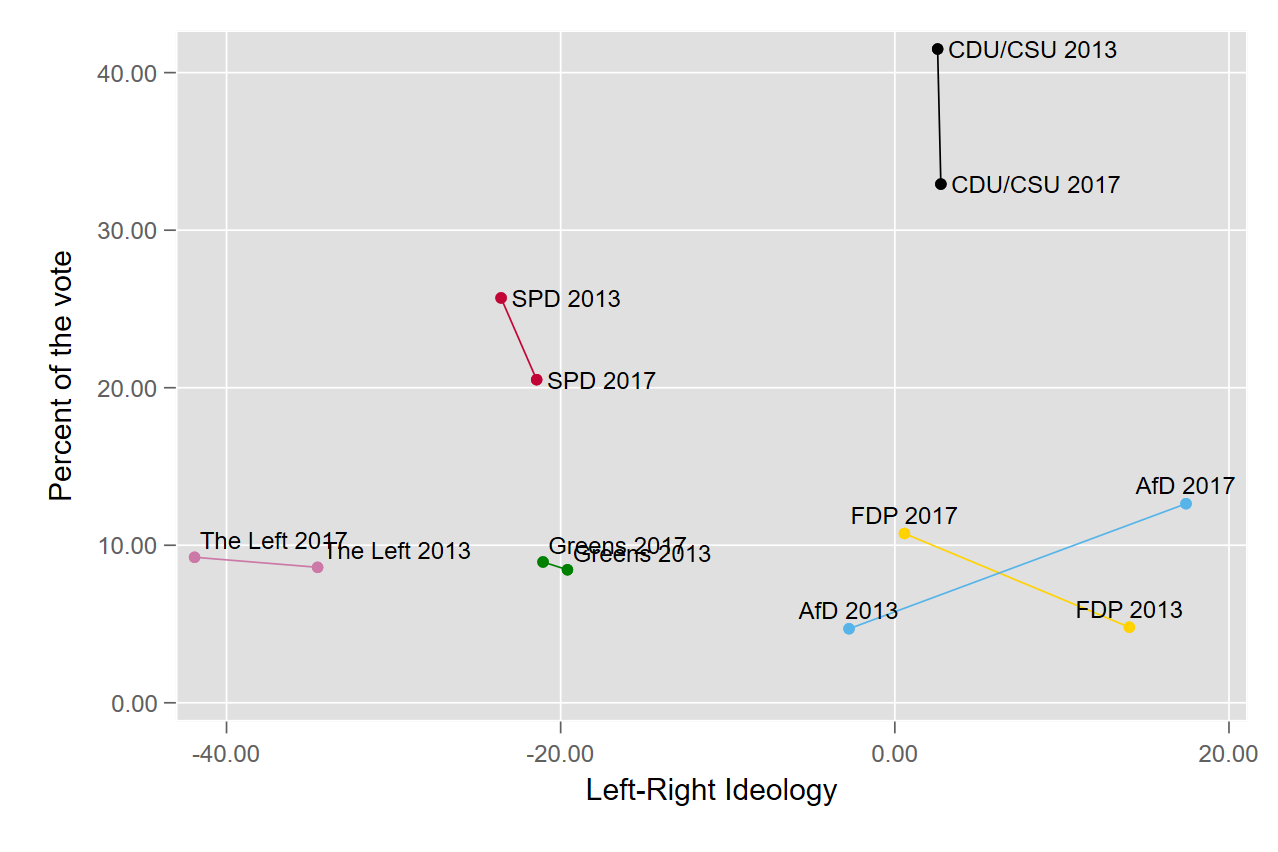
Note: Own illustration based on election programs collected and analyzed by the ‘Manifesto project’ (https://manifesto-project.wzb.eu).
The ‘metamorphosis’ of the AfD electorate
In analogy to the development from a primarily Eurosceptic to a populist radical right (PRR) party, we can observe a similar ‘metamorphosis’ (Bieber et al. 2018) among the voters and supporters of the AfD. In the early phase, voting for the AfD was largely motivated by negative attitudes towards European integration and immigration.[3] However, after the first internal split and the ‘refugee crisis’ in 2015, AfD support was more based on possessing a right-wing political ideology, ethnocentrism and opposition against cultural diversity, migration and refugees.[4] Similarly, the socio-demographic profile of the AfD electorate changed remarkably over time, turning a ‘party of the middle’ (Bergmann et al. 2017, 71) and a ‘party of the self-employed’ (Bieber et al. 2018, 449) into a ‘party of the Little People’ (Hambauer and Mays 2018, 150), of the workers and the less educated classes. Yet, other characteristics of AfD followers have remained constant over time. Most prominently, AfD voters have been persistently characterized by dissatisfaction with democracy and its institutions, anti-party sentiments and negative evaluations of the government and its performance.[5] The disdain for liberal, representative democracy among AfD voters is often accompanied by the wish for more populist conceptions of democracy, which implies more majoritarian, direct and anti-pluralist forms of democracy.[6] Moreover, supporters of the AfD continue to be rather male and concentrated in East Germany, i.e. in the states that succeeded the former Communist German Democratic Republic.
Figure 2: Socio-demographic characteristics of different German voter groups
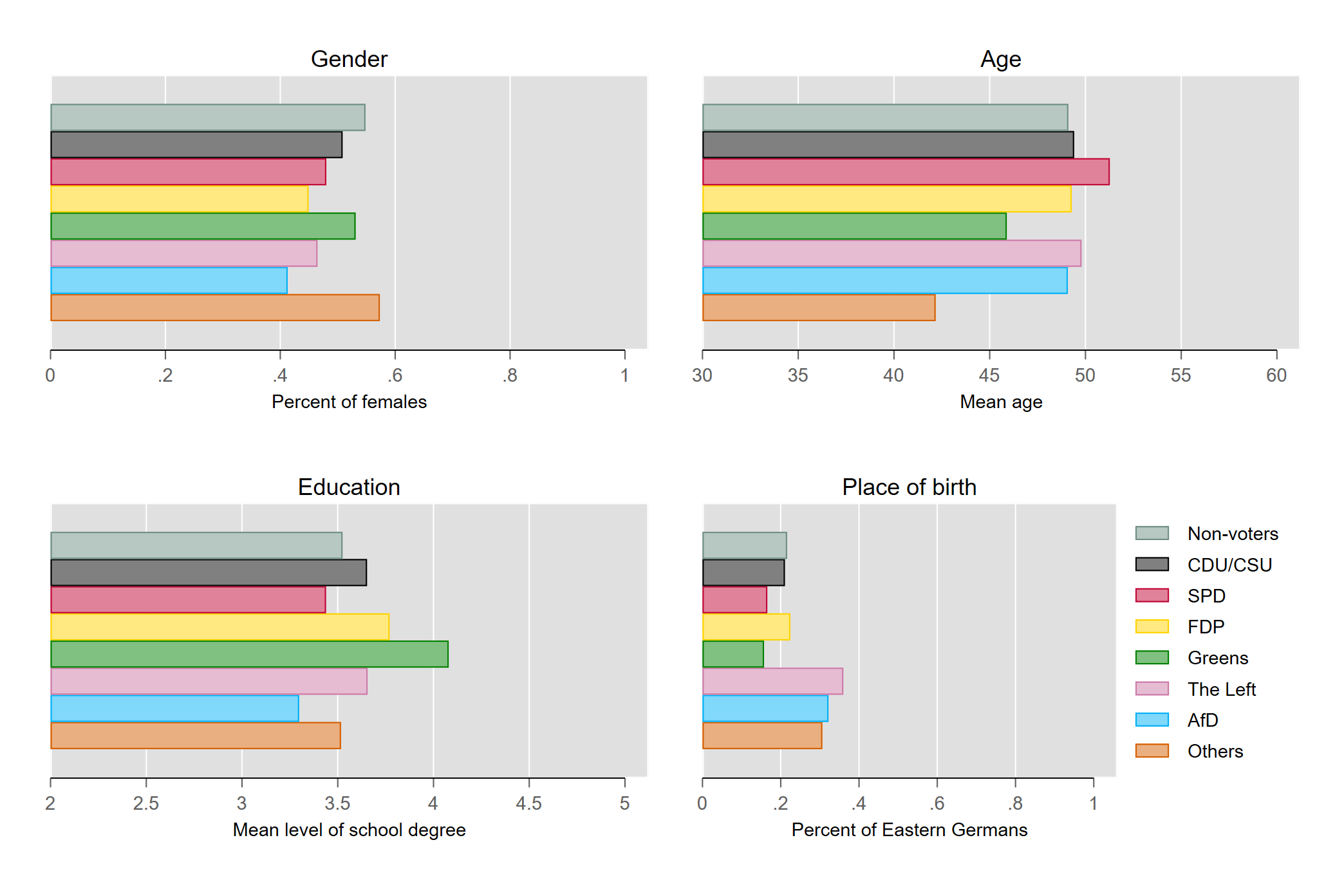
Note: Own illustration based on the 2017 German Longitudinal Election Study (short-term campaign panel).
The socio-demographic and socio-psychological profile of the AfD electorate can be empirically observed when analyzing survey data from the 2017 German Longitudinal Election Study (GLES).[7] Compared to the other voter groups, the voters of the AfD in the federal election have been rather male and comparably low educated (see figure 2). Furthermore, the percentage of Eastern German voters among the AfD electorate is much higher than for the other voter groups – except from voters of The Left, which is a direct descendant of the ruling party in the former German Democratic Republic (GDR). Although the socio-demographic profile is quite distinct from the profile of other voter groups, AfD voters are even more unique regarding their socio-psychological or socio-political characteristics (see figure 3). They locate themselves clearly towards the right of the ideological scale and score high on populist attitudes, while at the same time being deeply dissatisfied with the way democracy works in Germany. Interestingly, their mean level of (subjective) political interest is relatively high compared to other voter groups.
Figure 3: Socio-political characteristics of different German voter groups
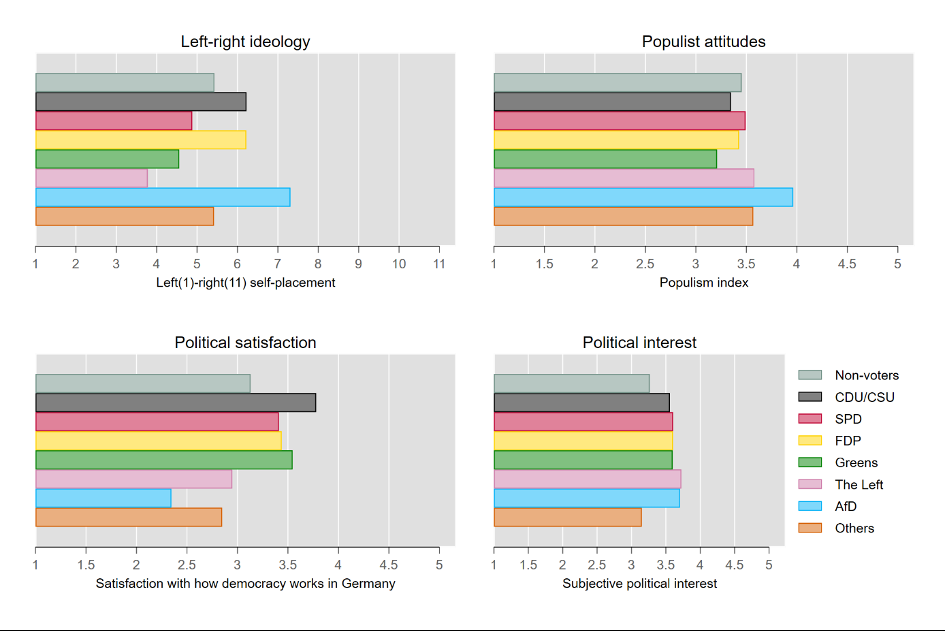
Note: Own illustration based on the 2017 German Longitudinal Election Study (short-term campaign panel).
Different kinds of AfD supporters
Although there can be various motivations of voting for a PRR party, two major explanatory approaches in political science are the ‘ideological/policy voting’ approach and the ‘protest voting’ approach.[8] The policy voting approach assumes that voters rationally choose a party based on issue preferences and policy congruence in order to maximize personal utility.[9] For voters of right-wing parties, this ideological or policy-based proximity refers, above all, to negative attitudes towards immigrants and the advocacy of a restrictive immigration and asylum policy.[10] As a prominent researcher on the radical right, Kai Arzheimer, concludes it his literature review: ‘A host of single-country and comparative studies have demonstrated time and again that anti-immigrant sentiment is the single most important driver of the Radical Right vote’ (Arzheimer 2018, 147). However, policy-related congruence between voters and parties is also relevant in other policy areas for the electoral support of ‘anti-establishment parties’ such as the AfD.[11]
In contrast, the notion of protest voting – defined as ‘a change of vote, motivated by political dissatisfaction, away from a mainstream party and for a party that consciously adopts the political stance of an outsider’ (Birch and Dennison 2019, 112) – implies that voters are not only rational, but also seek expressive motives.[12] In this sense, protest voters want to express their dissatisfaction with the ruling parties and incumbents as well as with the political establishment in general or even the entire political system. The Dutch radical right researcher Wouter van der Brug and his colleagues summarize this assumption as follows: ‘Compared to ideological and pragmatic voters, protest voters cast their vote not to affect public policies, but rather to express disenchantment with the political system or with the political elite’ (Van der Brug et al. 2000, 83). In particular, this aversion is directed against mainstream parties that embody the existing system and can be punished in elections.[13] In this case, populist parties appear as an attractive electoral alternative, especially due to their anti-elitist and anti-establishment rhetoric.[14]
Evidently, the two approaches – policy voting and protest voting – are conceptually different, but they are not contradictory. In reality, the factors ‘political dissatisfaction’ and ‘right-wing attitudes’ are highly correlated, partly because a preference for less immigration is rarely represented by mainstream parties and therefore often leads to disenchantment with politics.[15] But there seem to be also psychological reasons at play. As an example, it seems that authoritarian value orientations and a tendency to anger reactions correlates with political dissatisfaction on the one hand and a preference for right-wing parties on the other.[16] In the case of the AfD, the two explanatory approaches compete in political science research.[17] While some authors find that immigration attitudes and policy issues are the main factor driving the AfD vote,[18] others assess that support is primarily driven by political dissatisfaction.[19] Importantly, however, it can be observed that there are significant differences between typical policy voters and protest voters, for example regarding their political attitudes and their reactions towards political events.[20]
Figure 4: Distribution of policy voters and protest voters among the AfD electorate
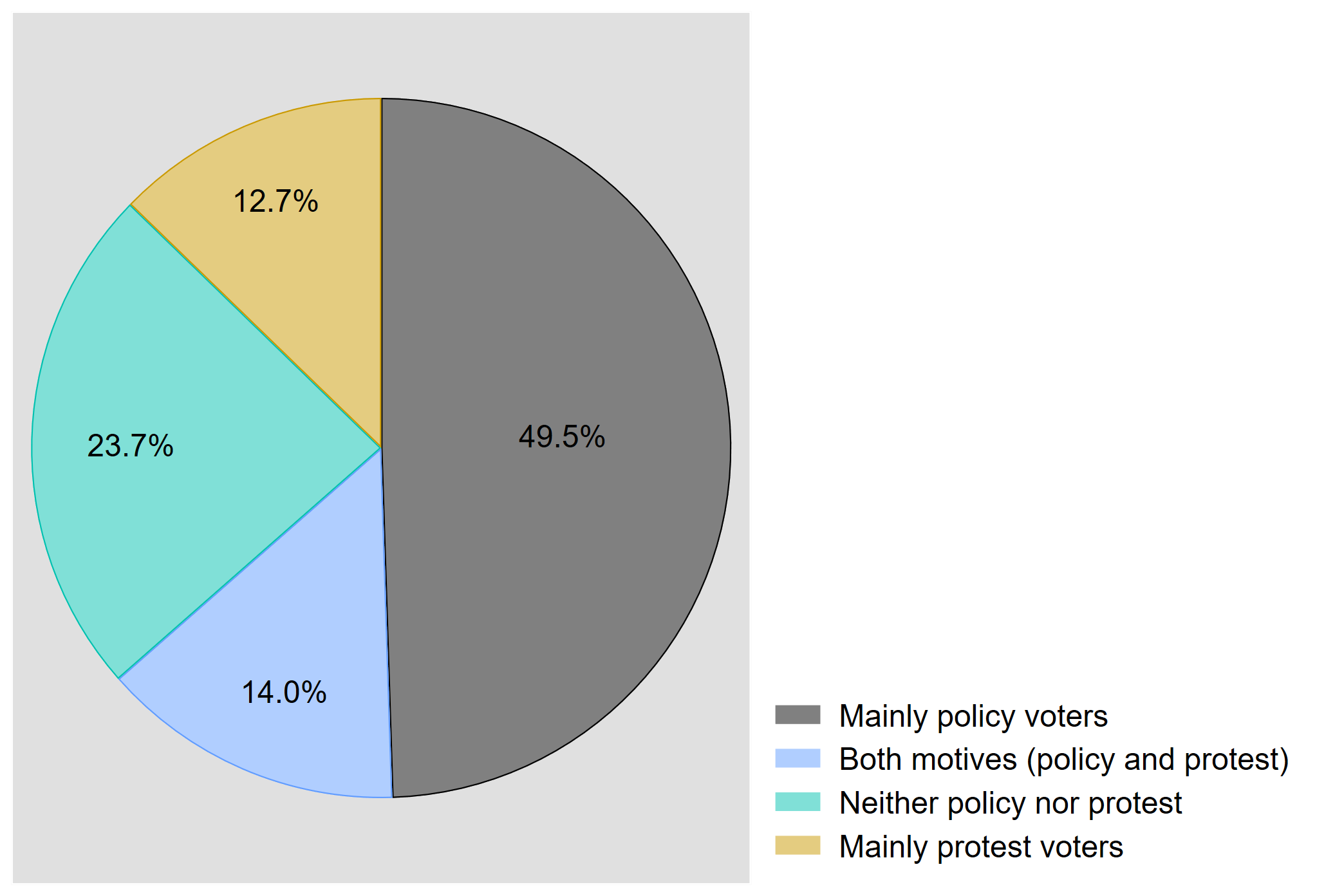
Note: Own illustration based on the 2017 German Longitudinal Election Study (short-term campaign panel, sub-sample of AfD voters, n=1.337). ‘Policy voting’ is defined as having high policy-congruence with the AfD on the issues of migration and socio-economic policy, whereas ‘protest voting’ is defined as identifying with another party than the AfD (for more information on the operationalization see Reinl and Schäfer 2020).
Looking at the AfD voters within the 2017 GLES panel survey (see figure 4), it can be observed that about half of the respondents (49.5%) can be branded ‘mainly policy voters’, meaning that they show high ideological and policy-related congruence with the AfD. Another 14% of the voters additionally indicate that they lean towards a different party than the AfD, which implies that they voted for the AfD both for ideological reasons as well as out of protest against their originally preferred mainstream party (‘policy and protest voters’). A share of 12.7% of the AfD electorate also express this identification with another party, but show no sign of ideological closeness, which is why they can be called ‘mainly protest voters’. The remaining 23.7% neither show policy-related congruence nor an affiliation with a mainstream party (‘neither policy nor protest voters’).
Figure 5: Socio-demographic characteristics of different AfD voter groups
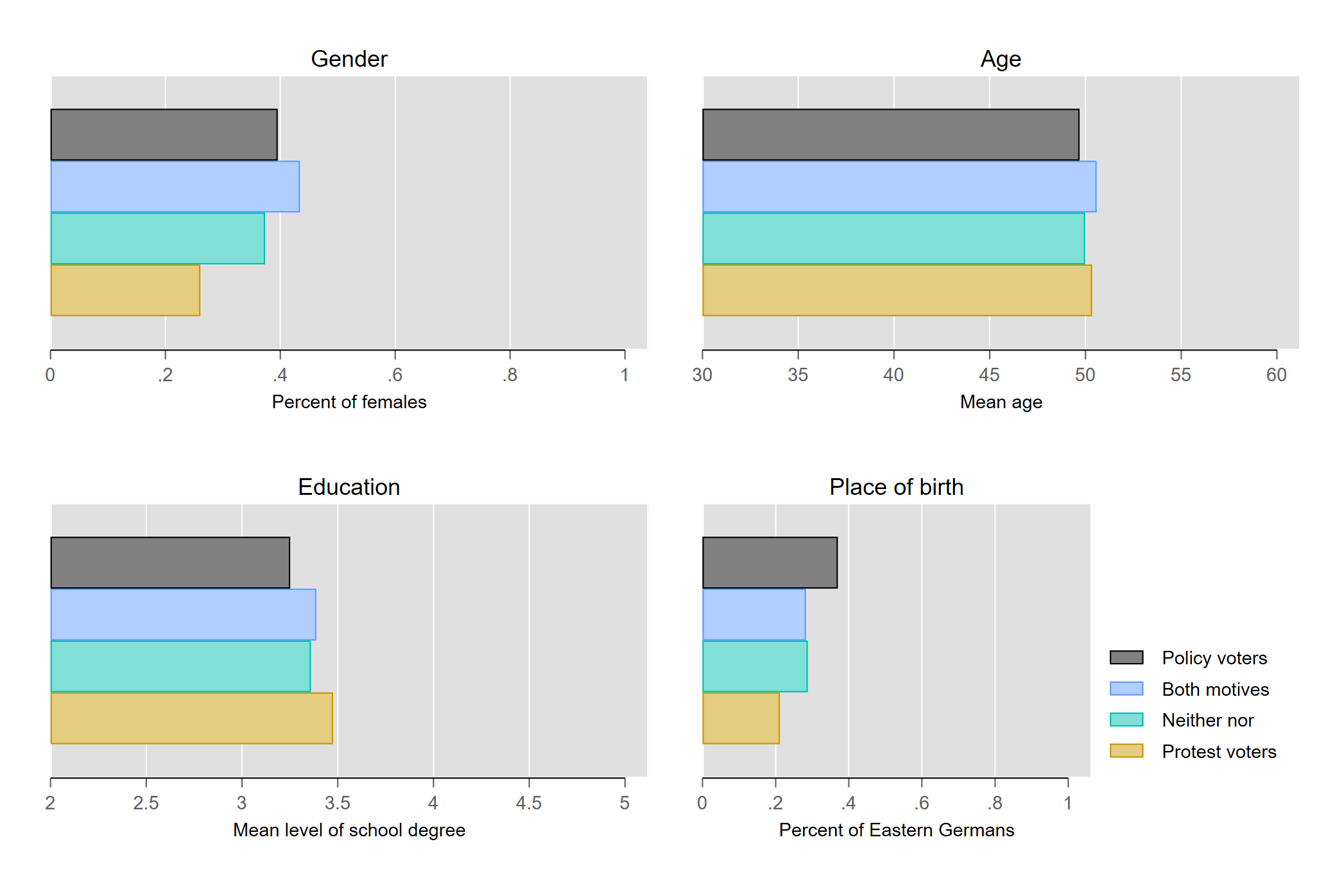
Note: Own illustration based on the 2017 German Longitudinal Election Study (short-term campaign panel, sub-sample of AfD voters, n=1.337).
Comparing the socio-demographic features of the different voter types within the AfD electorate reveals that the ideology-focused policy voters represent the youngest, least educated, and most East German group (see figure 5). In contrast, the protest voters are the most male, most educated and most West German group among the four AfD voter types. However, age differences are relatively small and both groups are comparably low educated and male-dominated.
The disparity between the two groups is more pronounced in socio-political terms (see figure 6). Policy voters show a much more distinct right-wing ideology, stronger populist attitudes, less satisfaction with democracy and lower political interest. It thus seems, as if their populist radical right ideology is strongly connected to their dissatisfaction with the German political system. In contrast, protest voters locate themselves more towards the ideological center, are less inclined to populism, are more satisfied with how democracy works in Germany and are the voter group with the highest political interest. They are less radical in their political views and appear a bit more like the other German voter groups (see figures 2 and 3).
Figure 6: Socio-political characteristics of different AfD voter groups
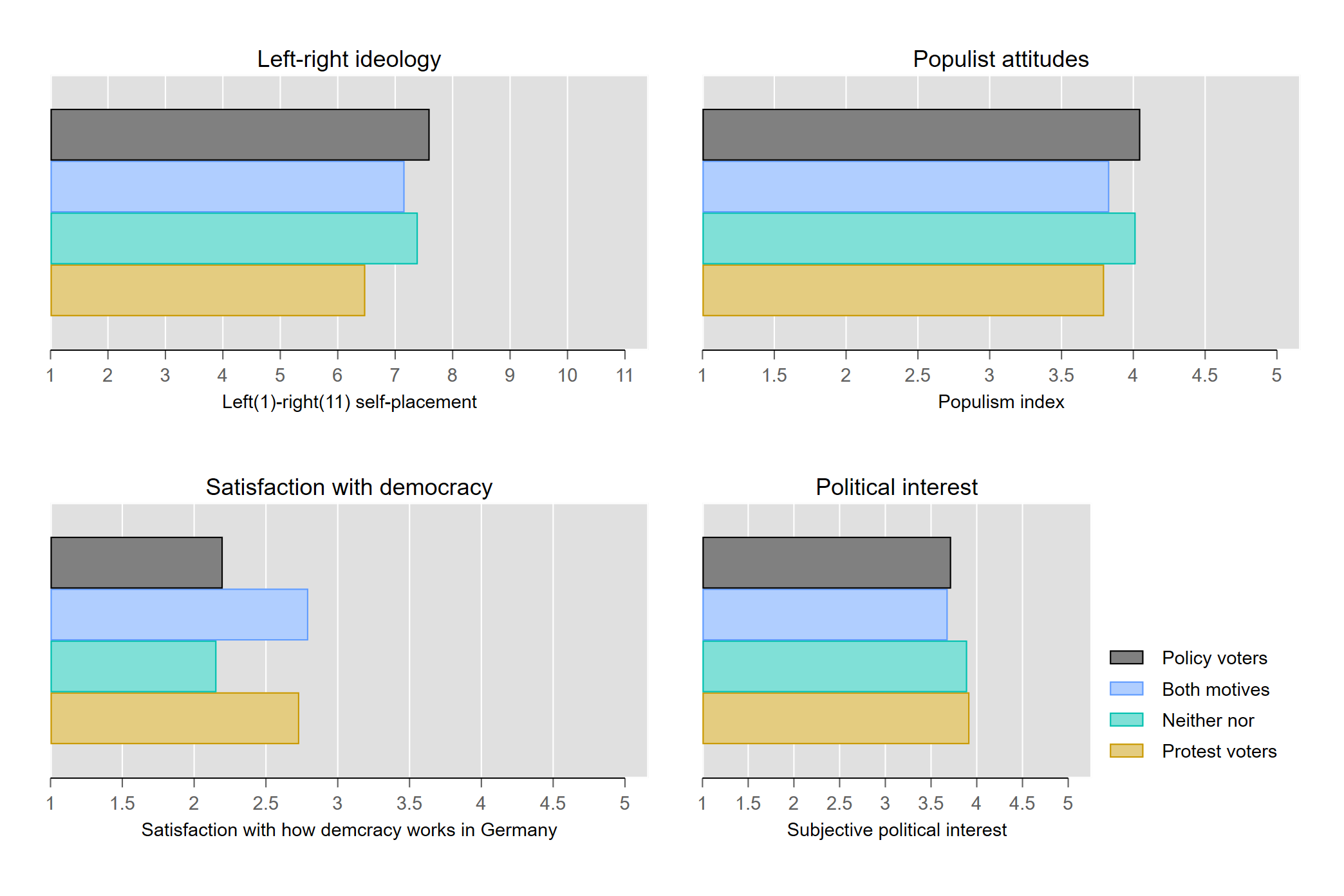
Note: Own illustration based on the 2017 German Longitudinal Election Study (short-term campaign panel, sub-sample of AfD voters, n=1.337).
Conclusion
In this contribution, I shortly summarized the political science literature on the ‘Alternative for Germany’ and, in particular, its voters. I then empirically demonstrated that the party took a strong turn to the ideological right between the 2013 and the 2017 federal elections and, in addition, I showed that the AfD electorate has a unique sociodemographic and socio-psychological profile. In particular, it is worth noting that AfD voters represent the most male and least educated electorate. They adhere to a populist right-wing ideology and are deeply dissatisfied with the democratic political system in Germany. Lastly, I illustrated that we can distinguish different types of AfD voters, for example those that support the party due to ideological and policy-based congruence and those that vote for the AfD out of protest against the mainstream parties.
All in all, it seems that AfD policy voters, who make up between half and two-thirds of the party’s electorate, seem to be the real core voters of the PRR party. They are the least educated voter group and have a disproportionately high Eastern German background. Additionally, they show the most profound right-wing ideological views, the highest leaning towards populism and a deep disdain for the liberal democracy in Germany. In contrast, the AfD protest voters’ share is significantly smaller and they seem to be more similar to the electorates of other German parties. This finding indicates that this group of people is primarily made up by mainstream party supporters who were dissatisfied with the handling of the ‘refugee crisis’ by the government and the ruling parties. Hence, they presumably used the opportunity of the 2017 federal election to lend their vote to the AfD, in order to express their dissatisfaction and to show a policy-based signal of where this dissatisfaction stems from.
Evidently, it will be highly interesting to see whether this last group – the protest voters – is going to switch back to their originally preferred party in the future. Recent polls indicate that the party has become less popular in the past few months and would currently obtain around 10% of the votes in a general election.[21] However, this trend is of course colored by the events around the ‘Corona crisis’, which has led to an increase in support for the governing parties CDU/CSU and SPD. It seems plausible that voters who possess a preference for these parties but voted for the AfD in 2017 switched back to their original preference in these polls, especially since immigration and asylum policy issues have become less salient topics in recent months.
Nonetheless, the fact that 10% of the German electorate still expresses an electoral preference for the AfD shows that the party has built up a solid amount of core supporters. These people might be those that I labelled policy voters – as their share in the polls closely match the numbers demonstrated here. The fact that these new core supporters stick to their party even in times of a very dramatic health crisis – instead of leaning towards the incumbents, as many others do – indicates that Germany’s first successful populist radical right party is not likely to vanish any time soon. Rather, it very much seems that the ‘AfD is here to stay’.[22]
[1] Arzheimer 2015; Arzheimer and Berning 2019; Berbuir et al. 2015; Jankowski and Lewandowski 2018; Lehmann and Matthieß 2017; Rosenfelder 2017
[2] Volkens et al. 2019
[3] Mader and Schoen 2015; Reher 2017; Schwarzbözl and Fatke 2016
[4] Bieber et al. 2018; Hambauer and Mays 2018; Hansen and Olsen 2019; Schmitt-Beck et al. 2017; Steiner and Landwehr 2018
[5] Bieber et al. 2018; Goerres et al. 2018; Hambauer and Mays 2018; Hansen and Olsen 2019; Schmitt-Beck et al. 2017; Schwarzbözl and Fatke 2016; Steiner and Landwehr 2018
[6] Steiner and Landwehr 2018
[7] GLES 2020
[8] see, e.g., Billiet and de Witte 1995; Erlingsson and Persson 2011; Hernández 2018; Schumacher and Rooduijn 2013; Van der Brug et al. 2000; Van Hauwaert and Van Kessel 2018
[9] Downs 1957
[10] Billiet and De Witte 1995; Ivarsflaten 2008; Van der Brug et al. 2000
[11] Bakker et al. 2020
[12] Brennan and Lomasky 1993
[13] Bélanger and Nadeau 2005; Hernández 2018: 460
[14] Bélanger and Aarts 2006; Rooduijn et al. 2016
[15] Arzheimer 2018, 147
[16] Birch and Dennison 2019, 113
[17] Goerres et al. 2018; Hambauer and Mays 2018
[18] Hansen and Olsen 2019; Wagner et al. 2019
[19] Schmitt-Beck et al. 2017
[20] Reinl and Schäfer 2020
[21] see, e.g., Politico 2020.
[22] This quote was made by Andreas Kalbitz, the AfD leader in Brandenburg, after the party had experienced great electoral successes in two 2019 state elections (Financial Times 2019)
References
Arzheimer, K. 2015. “The AfD: Finally a Successful Right-Wing Populist Eurosceptic Party for Germany?” West European Politics 38 (3): 535-556.
Arzheimer, K. 2018. “Explaining Electoral Support for the Radical Right.” In The Oxford Handbook of the Radical Right, edited by J. Rydgren, 143-165. New York: Oxford University Press.
Arzheimer, K., and C. Benning. 2019. “How the Alternative for Germany (AfD) and their Voters Veered to the Radical Right, 2013-2017.” Electoral Studies, online first: https://doi.org/10.1016/j.electstud.2019.04.004.
Bakker, R., S. Jolly, and J. Polk. 2020. “Multidimensional incongruence, political disaffection, and support for anti-establishment parties.” Journal of European Public Policy 27 (2): 292-309.
Bélanger, E., and K. Aarts. 2006. “Explaining the Rise of the LPF: Issues, Discontent, and the 2002 Dutch Election.” Acta Politica 41 (1): 4-20.
Bélanger, E., and R. Nadeau. 2005. “Political Trust and the Vote in Multiparty Elections: The Canadian Case.” European Journal of Political Research 44 (1): 121-146.
Berbuir, N., M. Lewandowsky, and J. Siri. 2015. “The AfD and Its Sympathisers: Finally a Right-Wing Populist Movement in Germany?” German Politics 24 (2): 154-178.
Bergmann, K., M. Diermeier, and J. Niehues. 2017. “Die AfD: Eine Partei der sich ausgeliefert fühlenden Durchschnittsverdiener?” Zeitschrift für Parlamentsfragen 48 (1): 57-75.
Bieber, I., S. Roßteutscher, and P. Scherer. 2018. “Die Metamorphose der AfD-Wählerschaft: Von einer euroskeptischen Protestpartei zu einer (r)echten Alternative?” Politische Vierteljahresschrift 59 (3): 433-461.
Billiet, J., and H. de Witte. 1995. “Attitudinal Dispositions to Vote for a ‘New’ Extreme Right-Wing Party: The Case of ‘Vlaams Blok’.” European Journal of Political Research 27 (2): 181-202.
Birch, S., and J. Dennison. 2019. “How Protest Voters Choose.” Party Politics 25 (2): 110-125.
Brennan, G., and L. Lomasky. 1993. Democracy and Decision: The Pure Theory of Electoral Preference. Cambridge: Cambridge University Press.
Downs, A. 1957. “An Economic Theory of Political Action in a Democracy.” Journal of Political Economy 65 (2): 135-150.
Erlingsson, G.O., and M. Persson. 2011. “The Swedish Pirate Party and the 2009 European Parliament Election: Protest or Issue Voting?” Politics 31 (3): 121-128.
Financial Times. 2019. “AfD makes strong gains in eastern German elections.” (https://www.ft.com/content/2c9be2aa-cc9d-11e9-99a4-b5ded7a7fe3f, last access: 05.05.2020).
GLES. 2020. GLES Short-Term Campaign Panel 2016-2019, Waves 1-10, GESIS Data Archive, Cologne. ZA6838 Data file Version 1.0.0. doi: 10.4232/1.13475.
Goerres, A., D. C. Spies, and S. Kumlin. 2018. “The Electoral Supporter Base of the Alternative for Germany.” Swiss Political Science Review 24 (3): 246-269.
Hambauer, V., and A. Mays. 2018. “Wer wählt die AfD? – Ein Vergleich der Sozialstruktur, politischen Einstellungen und Einstellungen zu Flüchtlingen zwischen AfD-WählerInnen und der WählerInnen der anderen Parteien.” Zeitschrift für Vergleichende Politikwissenschaft 12: 133-154.
Hansen, M. A., and J. Olsen. 2019. “Flesh of the Same Flesh: A Study of Voters for the Alternative for Germany (AfD) in the 2017 Federal Election.” German Politics 28 (1): 1-19.
Hernández, E. 2018. “Democratic Discontent and Support for Mainstream and Challenger Parties: Democratic Protest Voting.” European Union Politics 19 (3): 458-480.
Ivarsflaten, E. 2008. “What Unites Right-Wing Populists? Re-Examining Grievance Mobilization Models in Seven Successful Cases.” Comparative Political Studies 41 (1): 3-23.
Jankowski, M., and M. Lewandowsky. 2018. “Die AfD im achten Europäischen Parlament: Eine Analyse der Positionsverschiebung basierend auf namentlichen Abstimmungen von 2014-2016.” Zeitschrift für Vergleichende Politikwissenschaft 12: 567-589.
Lehmann, P., and T. Matthieß. 2017. “Nation und Tradition. Wie die Alternative für Deutschland nach rechts rückt.” WZB Mitteilungen 156: 21-24.
Mader, M., and H. Schoen. 2015. “Chancellor Merkel, the European Debt Crisis and the AfD: An Analysis of voting Behaviour in the 2013 Federal Election.” In Germany after the 2013 Elections: Breaking the Mould of Post-Unification Politics, edited by G. D’Ottavio, and T. Saalfeld, 89-110. London/New York: Routledge.
Politico. 2020. “Poll of Polls: Germany – National parliament voting.” https://www.politico.eu/europe-poll-of-polls/germany/ (last access: 05.05.2020).
Reher, S. 2015. “Explaining Cross-National Variation in the Relationship Between Priority Congruence and Satisfaction with Democracy.” European Journal of Political Research 54 (1): 160-181.
Reinl, A., and C. Schäfer. 2020. “How the 2017 Federal Election in Germany Affected Satisfaction with Democracy among AfD Voters.” German Politics, online first: https://doi.org/10.1080/09644008.2020.1741550.
Rooduijn, M., W. van der Brug and S. L. de Lange. 2016. “Expressing or Fuelling Discontent? The Relationship Between Populist Voting and Political Discontent.” Electoral Studies 43: 32-40.
Rosenfelder, J. 2017. “Die Programmatik der AfD: Inwiefern hat sie sich von einer primär euroskeptischen zu einer rechtspopulistischen Partei entwickelt?” Zeitschrift für Parlamentsfragen 58 (1): 123-140.
Schmitt-Beck, R., J. W. van Deth, and A. Staudt. 2017. “Die AfD nach der rechtspopulistischen Wende. Wählerunterstützung am Beispiel Baden-Württembergs.” Zeitschrift für Politikwissenschaft 27 (3): 273-303.
Schumacher, G., and M. Rooduijn. 2013. “Sympathy for the ‘devil’? Voting for populists in the 2006 and 2010 Dutch general elections.” Electoral Studies 32 (1): 124-133.
Schwarzbözl, T., and M. Fatke. 2016. “Außer Protesten nichts gewesen? Das politische Potenzial der AfD.” Politische Vierteljahresschrift 57 (2): 276-299.
Steiner, N. D., and C. Landwehr. 2018. “Populistische Demokratiekonzeptionen und die Wahl der AfD: Evidenz aus einer Panelstudie.” Politische Vierteljahresschrift 59 (3): 463-491.
Van der Brug, W., M. Fennema, and J. Tillie. 2000. “Anti-immigrant Parties in Europe: Ideological or Protest Vote?” European Journal of Political Research 37 (1): 77-102.
Van Hauwaert, S. M., and S. Van Kessel. 2018. “Beyond protest and discontent: A cross-national analysis of the effect of populist attitudes and issue positions on populist party support.” European Journal of Political Research 57 (1): 68-92.
Volkens, A., W. Krause, P. Lehmann, T. Matthieß, N. Merz, S. Regel, and B. Weßels. 2019. The Manifesto Data Collection. Manifesto Project (MRG/CMP/MARPOR). WZB, Berlin. Version 2019a. https://doi.org/10.25522/manifesto.mpds.2019a.
Wagner, A., H. Giebler, and M. Lewandowsky. 2019. Legitime Motive? In Legitimität und Legitimation. Vergleichende Perspektiven, edited by C. Wiesner und P. Harfst, 171 - 202. Wiesbaden: Springer VS.


